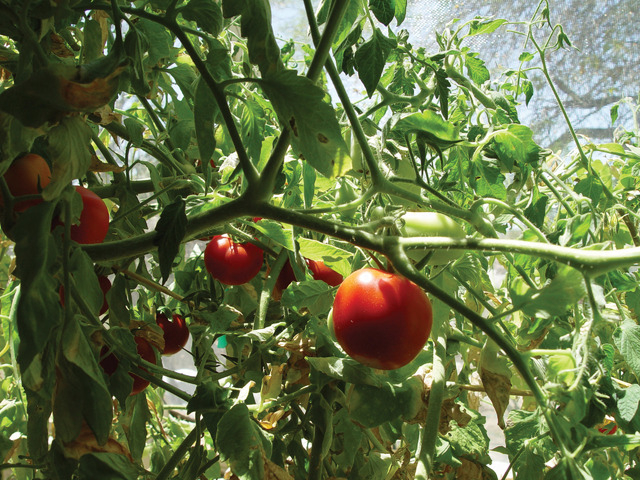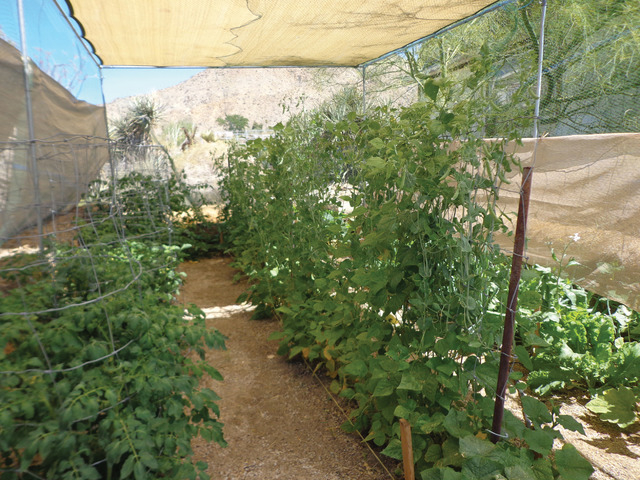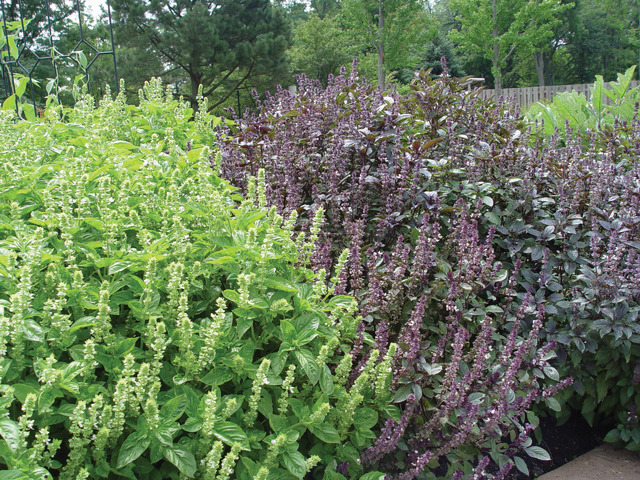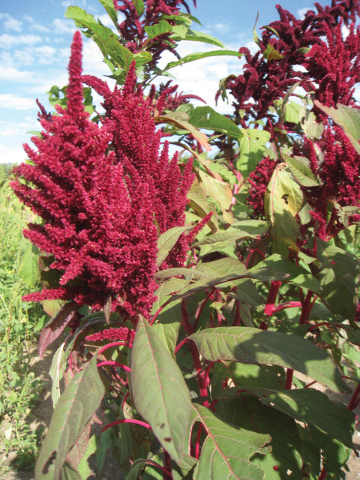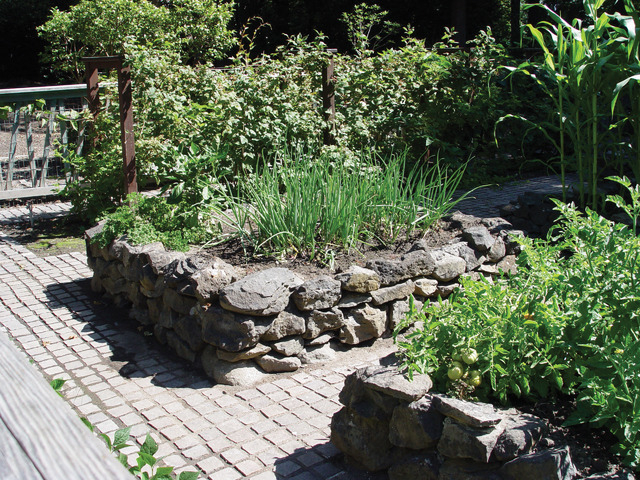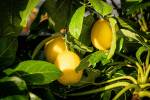Growing vegetables in the desert
Planting a summer vegetable garden in our high-desert climate with its ovenlike temperatures, punishing winds and moisture-slurping atmosphere is not for the timid.
Yet, when the result is a booming crop — whether it’s one plant dripping with cherry tomatoes or a garden bed full of everything from peppers to melons — the rewards are that much sweeter. According to experts, even first-time home gardeners can take on whatever summer has to dish out by following some basic practices.
It all starts with a rich planting soil that allows vegetables to take root and even thrive in our brutal summer conditions, a significant challenge in Southern Nevada, where the soil can be sandy, gravelly, high in salts and often plagued by layers of hard caliche and clay.
Ideally, a home vegetable garden would be planted in a raised bed, basically an oversized planter, that can be filled entirely with quality commercial potting soil containing lots of nutrients and organic material. The soil should have a good balance of the big three — nitrogen, phosphorous and potassium — which ensure plants do everything from establish roots to develop green leaves and strong stems.
While water drainage may be a concern for gardeners in cooler, wetter climates, in Southern Nevada it’s important to have good water retention. Maureen Gilmer, author of “Growing Vegetables in Drought, Desert and Dry Times” (Sasquatch Books, 2015), noted that potting soil is full of porous ingredients such as perlite, those white granules sprinkled throughout various commercial soils, and flecks of woody material that allow precious water to filter through too easily. She uses a water-absorbent soil from Black Gold called Waterhold Cocoblend.
Those working with our existing soils should add lots of fine, organic material to build up a living environment full of microorganisms and nutrients. That can take a lot of trial and error, and every home gardener or expert has their own tricks up their sleeves.
Based on Gilmer’s book and advice from the Nevada Cooperative Extension Service, amendments can include compost; poultry and steer manure; worm castings, which contain high levels of microbes and micronutrients; coir, a byproduct of coconuts that improves absorbency; and organic fertilizers to supply and replenish nutrients. And a high-quality potting soil can be used as well.
If a vegetable garden is floundering, nearly any issue can be addressed by first adding a generous amount of quality compost, according to Gilmer. If that doesn’t help, add organic fertilizer, and, finally, make sure there’s enough moisture.
“The first year, just make it and grow it, and then the second year start adding your fertilizers and nutrients. But if you start with good quality potting soil, you won’t have so much concern in year two or three,” Gilmer added.
Once seeds and transplants are in the ground, they should be protected with shade cloth. It keeps the soil’s temperature down, protects plants from the punishing afternoon sun, including the extreme ultraviolet rays we get in the high desert, offers wind protection, aids in water retention and is also a natural pest repellent, said Angela O’Callaghan, social horticulture specialist with the University of Nevada Cooperative Extension.
There are row covers, or tunnel-like shading made from hoops that bend over the plants and are covered with a polypropylene cloth. There are also lightweight shade cloths that lie on top of plants called floating row covers, and handy home gardeners can always create their own covers by using half-inch PVC pipe and shade cover bought at garden or home-supply stores, according to the experts.
In addition to good soil and shade, desert gardeners will want to put mulch around the base of their plants to help prevent evaporation of precious water and keep the soil and roots cooler. The soil under a generous layer of straw can be up to 20 degrees cooler than soil without mulch, according to O’Callaghan.
Examples of mulch materials include straw, shredded leaves and wood chips. Gilmer noted that alfalfa also works well and has the extra benefit of adding nitrogen to the soil. Mulch should be placed at least 1 inch away from a plant’s stem, she added.
Finally, O’Callaghan noted that mulch should have a depth of no more than 3 inches, but gardeners can initially place up to 4 inches around a plant because it will compact down.
Once the soil is a living environment in which plants can thrive, once the shade has been put up and the mulch laid down, just how much precious Southern Nevada water should be used to ensure all that hard work is going to pay off?
O’Callaghan doesn’t give specific watering recommendations because it depends on varying factors, such as what types of vegetables are being grown and the makeup of the soil. She does suggest that gardeners regularly check the soil to make sure it feels like a “well-wrung-out sponge.”
“You don’t want it to dry out much more than that, and you don’t want it to be much wetter than that because if they don’t have good drainage, if those roots are sitting in soil that’s too wet, the roots literally stop working,” she said.
Both Gilmer and O’Callaghan emphasized that it’s important to continually observe what’s going on in the garden so any problems, such as pests or watering issues, can be spotted before they get out of hand.
And don’t be intimidated. Even the experts are continually figuring things out.
“You’ll always learn more from what you do wrong than what you do right. So if you make a mistake, celebrate what you learned from that mistake, don’t beat yourself up over it,” Gilmer said.
Here are some more expert tips:
n There are potting soils that contain biosolids or sewage sludge, so gardeners who aren’t comfortable with that should read the list of ingredients. The sewage sludge can contain heavy metals that build up in the soil, Gilmer said.
n Tomatoes are perennials and warm-season veggies. O’Callaghan recommends harvesting them when they’re ready, then cutting them back and putting down mulch to help keep the soil moist. They will come back around September.
n The tobacco horn worm loves the leaves of tomato plants, but there is a product gardeners can use called bacillus thuringiensis or B-T, a bacteria that produces a toxin safe for humans but harmful for the pesky caterpillars, according to O’Callaghan.
n O’Callaghan noted that gardeners often plant seeds too deep. The trick is to look at the widest part of the seed and plant it as deep as it is wide. A seed one-half inch wide should be planted one-half inch deep.
n Instead of using hoops as a structure for row covers that are battered by high winds, gardeners can us strong welded-wire mesh bought from home-supply stores, Gilmer said.
n Plants that can be started from seed late in the planting season, beginning around April, are okra, melons, squashes and sweet potatoes. But make sure that they stay moist and that there are good phosphorous and potassium levels in the soil and plenty of mulch, O’Callaghan said.
n A good and inexpensive way to fertilize raised beds is by using alfalfa pellets that are used for animal feed. “You can mix them into your soil really, really easy ,and then they absorb all this water and explode into this nitrogen and organic-matter wonder deep underneath there,” Gilmer said.



